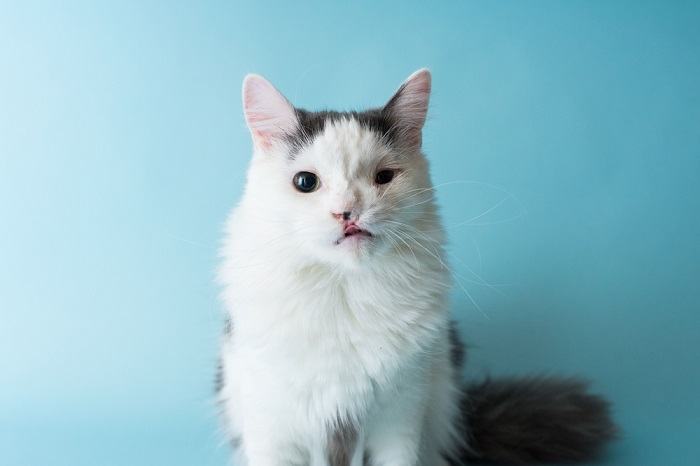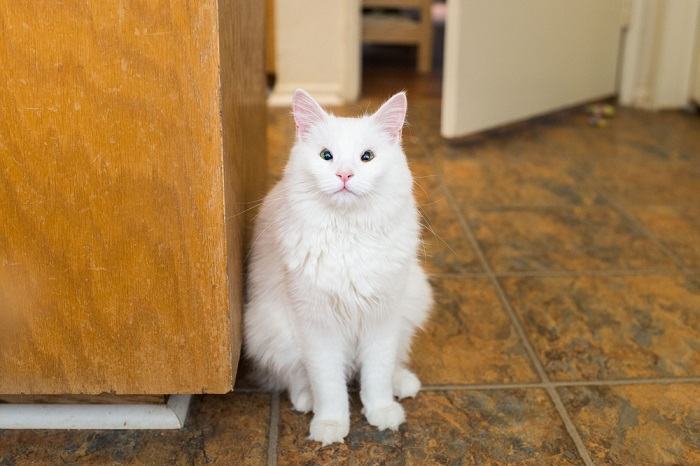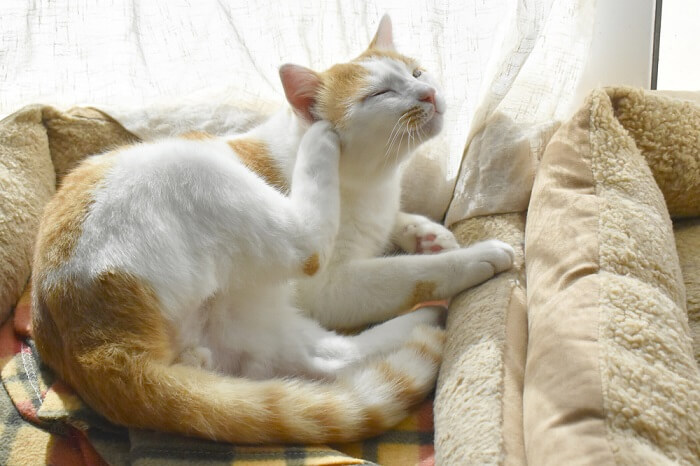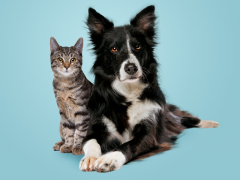
Neomycin is an antibiotic most often used in veterinary medicine as part of a triple combination topical medication for disorders of the eye. In this article, you’ll learn about how neomycin acts against bacteria, formulations it comes in, side effects and precautions to be aware of, and some frequently asked questions.
Neomycin for Cats Overview

About Neomycin for Cats

Neomycin is an aminoglycoside antibiotic. This class of antibiotics acts on bacteria by interfering with the bacteria’s ability to synthesize certain proteins needed for their growth and reproduction.
Aminoglycosides, which also include antibiotics like amikacin and gentamicin, primarily act against aerobic, or oxygen dependent, gram-negative staining bacteria like Pseudomonas and Enterobacter. They can also have some effect against gram-positive staining bacteria.
Neomycin comes in both oral and topical forms. The oral form is uncommonly used in veterinary medicine, but may be rarely considered in cases to reduce bacterial growth in the digestive tract. This may be in preparation for a procedure like colon surgery, or to reduce ammonia-producing bacteria that are contributing to signs of a liver disorder called hepatic encephalopathy.
Oral neomycin is not well absorbed, and so its general use as an oral antibiotic is very limited. The injectable form comes with significant concerns for kidney toxicity, making its other injectible antibiotic cousins more likely choices if indicated.
Neomycin is most often used as a topical preparation for the skin and eyes. Usually, it is in combination with two or more other ingredients to make a “triple” antibiotic ointment. Examples include neomycin with polymyxin B and gramicidin or bacitracin, and neomycin with polymyxin B and dexamethasone.
Tresaderm, which is labeled for use in cats for topical treatment of skin and ear infections, contains neomycin along with the corticosteroid dexamethasone, and antifungal thiabendazole.
What Does Neomycin Do for Cats?

Most commonly, neomycin may be used topically in cats for small wounds on the skin, local areas of bacterial infection, and for ear infections caused by bacteria.
It is also common to use neomycin ophthalmic ointment preparations for eye disorders where bacterial infection is thought to be involved, like corneal scratches, corneal ulcers, conjunctivitis (infection of the eyes under the lids), or blepharitis (infection of the lids themselves).
Side Effects of Neomycin for Cats

Neomycin may be used topically to treat small wounds on the skin, local areas of infection, and ear infections.
Some cats can have a topical hypersensitivity or reaction to either neomycin, polymyxin B (which it is often paired with) or both.
At the low end, this may be seen as itching, scratching, or irritation at the application site. At worse, a severe allergic or anaphylactic reaction may occur.
Fortunately, this type of reaction has not been associated with products containing a steroid (like dexamethasone, hydrocortisone, betamethasone, or triamcinolone).
As a majority of neomycin products used in veterinary medicine do contain a steroid to address skin or eye inflammation, serious reactions to most veterinary products appear to be uncommon.
But because neomycin is a common ingredient in many over-the-counter triple antibiotic ointment products that don’t contain steroids (Neosporin, etc.), it’s important to always look at the ingredients of any OTC product you plan to use for your pet, and check with your veterinarian before using it.
Any eye medication containing a steroid has the potential to worsen disease if a corneal ulcer is present. A corneal ulcer is where a scratch or abrasion on the eye gets infected and starts to erode the corneal surface.
This is why it is very important not to use a steroid-containing medication in the eye unless you have been directed to do so by your veterinarian. During an exam of an eye issue, a veterinarian will often apply a stain called fluorescein to the eye to check for the presence of an ulcer and make sure that using a product containing a steroid is safe.
It’s also very important to be aware of the form or type of neomycin topical preparation you have. There are brands and generic products for skin, ear, and eye products and it is very important not to use skin/ear products in the eyes.
Neomycin for Cats Dosage

Your veterinarian will instruct you how to give neomycin, including how much and how often to give it your cat.
For most topical eye preparations, a single drop or about a ¼-inch strip of ointment is used, anywhere from twice a day up to three to four times per day in the affected eye.
For other topical preparations for the skin and ears, application every 12 hours is common. But it’s important to follow your veterinarian’s instructions, as application amount and frequency may differ depending on what is being treated.
For the oral form of neomycin, a dose is not provided here, as it is an uncommonly used form except for very specific circumstances and in those cases, a veterinarian’s instructions should be closely followed.
Conclusion

While the oral form is uncommonly utilized in veterinary medicine, neomycin is a very common ingredient in topical preparations for the eyes, ears, and skin.
Some cats may have allergic sensitivities to neomycin, which is seen less commonly in combination products also containing a steroid.
It’s always important to check first with your vet before using an over-the-counter product containing neomycin, or a previous prescription product containing neomycin that you may still have at home.
Frequently Asked Questions
What is neomycin and polymyxin B sulfates used for in cats?
Most commonly, neomycin and polymyxin-B are found in topical combination products used in cats to treat eye infections, like conjunctivitis. It is common to find them also paired up with a third ingredient, such as a steroid like dexamethasone.
Is neomycin ointment safe for cats?
Some cats can have a mild to severe allergic sensitivity to neomycin. This may appear mildly as some scratching or irritation at an application site, or may present as an anaphylactic reaction. Fortunately, it does appear that such reactions are far less recognized in neomycin products containing a steroid, which a majority of veterinary medications containing neomycin (Animax, Entederm, Tresaderm) contain.
Can you use neomycin and polymyxin B sulfates and hydrocortisone otic in cats?
It’s important to never use ear medication in your cat without first consulting with your veterinarian. This is especially true of any human medication preparations. The only product labeled for use in cats for ear infections currently is Tresaderm, though veterinarians may use some products approved for dogs in an off-label manner in cats.
What is neomycin used for in animals?
Neomycin is an antibiotic with a spectrum of action against certain bacteria. The oral form is used uncommonly in animals as a way of “sterilizing” the gut to either reduce ammonia-producing bacteria or prepare the colon for surgery. More often, neomycin is used as part of a combination product, or “triple” antibiotic ointment for treating eye, ear, and skin infections in pets.








This article confirms my suspicion that my cat has a sensitivity to nyomycin, polymyxin B sulfate and zinc oitment but it does not suggest what to do. Do I continue medicating from today Friday hntil Tuesday when my veterinarian returns to the office?
Hi Lucia,
This depends a lot on what is being treated and how bad the sensitivity is. To stop the sensitivity reaction, it would be necessary to stop the ointment. However, if we’re treating an infected area, it is important to remember that the ointment may be the only thing currently being used to address it and even with the sensitivity, it is still treating an infection. An alternative ointment/therapy may be needed, but hopefully as you mentioned today your vet will be in and you can discuss some alternative treatment options if needed. I hope that is helpful for you.
Dr. Vanderhoof
Question:
Neomycin, Polymyxin B Sulfate, Bacitracin Zinc Ointment by Bausch & Lomb RX for cat conjunctivitis is the same active ingredients as Neosporin for human use. Why are there so many warnings about using Neosporin on cat wounds? One of my current rescue cats has abscess at base of ear- most likely from scratching itself or from a fight scratch wound. If a cone is used to prevent ingestion, is it safe to use as antibacterial ointment? I’ve keep the wound area clean, warm compress, etc but I’d like to prevent further infection.
Hi Aniko, thanks for your question. In some cats, neomycin and/or polymyxin B can cause a bad allergic reaction, which is probably a main reason you’re seeing warnings. This is not a risk associated with licking the ointment off and is instead associated with topical application. It appears that in many cases, a cat may become more sensitive to the drugs over time, so you might see signs of application site irritation first, but anaphylaxis reactions have been reported. Many folks use Neosporin and similar products on their cats with no reported issues, but perhaps either these cats are not hypersensitive to it or it’s used infrequently enough that they don’t develop a hypersensitivity to it.
Using an Elizabethan collar is a great idea to prevent further trauma or introduction of bacteria to the wound. But of course, I”m going to suggest that any bite wound or abscess be examined by a vet. Sometimes, these wounds are deep puncture type wounds which make it hard for topical creams or ointments to really help, and they require systemic antibiotics for the most rapid and effective healing.
Our vet prescribed Neomycin and Polymyxin B Sulfates and Dexamethasone for one drop to each nostril 2x daily for 7 days (Burmese cat). At age 11 years she has had some discharge from nostrils since we got her a year ago. She pulls away and right away licks and swallows the Rx if I’m able to get some on her nose. She plays, sleeps, and eats well without it. Any suggestion?
Hi Connie,
Using this medication intranasally is an off-label use for it, and it would be best to consult with your veterinarian if you don’t feel this route of administration is effective. In my experience, cats don’t take kindly to nasal drops all that well and what you’re describing when trying to give them is typical.
It’s also a good idea to speak with your vet if you are concerned that a treatment approach may be causing more stress for your cat than benefit.
It is unclear what the cause of the nasal discharge is, as there could be many. My one thought is if your older cat has had this chronically since she was adopted but otherwise seems unaffected in her day to day, it’s possible she could have a chronic rhinitis, or chronic inflammation of the nasal passages.
Cats can have chronic symptoms and may be at risk for upper respiratory infection flare-ups to keep an eye out for, but some can have long term symptoms like congestion or runny nose that don’t otherwise affect them too badly. Diagnosis for this requires more advanced CT imaging and a nasal biopsy. Not everyone takes that step if their cat copes with the symptoms.
Thank you Dr. Vanderhoof for your comments. BTW, she is a retired breeder who was given to us because the owners could no longer care for her. As an indoors-only cat, she is typical of her breed–fun and smart.
So we have Neomycin and Polymyxin B sulfates, Bacitracin Zinc and Hydrocortisone Ophthalmic Ointment. Can I use it on my cats skin. We woke up one day and noticed a bald spot on him one of his shoulder blades. It is red and looks irritated.
Thank you
Hi Arianna, the ophthalmic preparations may be less effective for use on the skin. It gets into how different medication solutions are designed to penetrate different types of tissue layers. It’s also important to remember that some cats may have an allergic reaction to Polymyxin B.
I’m currently using this medication for my ragdoll who has had a discharge in his eyes since we have had him. After only three dosages it is helping. After using the prescribed dosage will this supposedly cure his problem? I hope this is something I don’t have to continue using the remainder of his life. It is difficult getting in his eyes.
Hi Diana,
I can’t possibly know if this will cure your kitty’s eye issues for sure, as I don’t know what the true diagnosis is. Neomycin can be effective against certain bacteria that cause conjunctivitis. If it is uncomplicated conjunctivitis, it can often resolve in a week or so.
But there can be underlying health conditions, like viral infections like feline herpes virus, that may lead to recurrent conjunctivitis. Underlying stress, perhaps of moving to a new home, can contribute too.
Hopefully, if you’re already seeing improvement in just three days, that’s a good sign. If you do see signs recur for some reason, work with your veterinarian to figure out what the underlying cause might be.